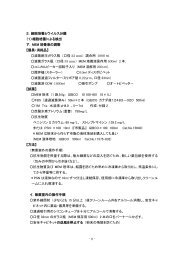Program and Abstracts(PDF)
Program and Abstracts(PDF)
Program and Abstracts(PDF)
Create successful ePaper yourself
Turn your PDF publications into a flip-book with our unique Google optimized e-Paper software.
Poster presentation 20<br />
EFFECT OF ATP AND IMP ON THE QUALITY OF FISH AND FISH PRODUCTS<br />
Yuko Murata<br />
National Research Institute of Fisheries Science, Yokohama, Kanagawa 236-8648, Japan<br />
Email: betty at affrc.go.jp<br />
ATP <strong>and</strong> its related compounds, that is ATP, ADP, AMP, IMP, HxR <strong>and</strong> Hx are the main<br />
nucleotides in fish muscle. The composition of nucleotide related compounds (Nu-ATP) in<br />
fish muscle can be considered as an indicator of freshness. The components of Nu-ATP in fish<br />
muscle dramatically change after death. In live fish muscle, most Nu-ATP is ATP <strong>and</strong> just<br />
after death, more than 90% of Nu-ATP in the muscle is ATP. After death however, ATP is<br />
degraded to ADP, AMP, <strong>and</strong> then to IMP. ATP has a suppressive effect on denaturation of the<br />
myofibrillar protein of muscle. Therefore, micro-sized meat with a high content of ATP from<br />
fishes immediately after instant killing has a good gel forming ability by addition of only a<br />
low concentration of salt <strong>and</strong> shows good freeze tolerance. These facts suggest that for<br />
processing, especially, for surimi processing <strong>and</strong> freezing, using fishes with a high content of<br />
ATP, i.e. using fishes immediately after killing, enables to keep a high quality of the products.<br />
However ATP is tasteless <strong>and</strong> the taste of such fishes with a high ATP content is negligible.<br />
On the other h<strong>and</strong>, IMP contributes to an umami taste <strong>and</strong> has a synergistic effect on sweet<br />
<strong>and</strong>/or umami tastes of various amino acids. IMP content is negligible just after death <strong>and</strong><br />
accumulates depending on the degradation of ATP. Thus, according to the accumulation of<br />
IMP, the umami taste of fish muscle increases. Up to 7~10hr after death, more than 80% of<br />
Nu-ATP is IMP, <strong>and</strong> the umami taste of fish muscle is enriched. These results suggest that the<br />
best time to eat, that is fish when it is most delicious, is 7~10hr after death.<br />
Annotated Bibliography of Key Works<br />
Kawai, M., Okiyama, A., Ueda, Y. 2002. Taste Enhancements Between Various Amino Acids<br />
<strong>and</strong> IMP. Chem. Senses, Vol.27, Pp 739-745.<br />
It is well known that a strong synergistic interaction of umami occurs between L-α-amino<br />
acids with an acidic side chain, such as L-Glu or L-Asp, <strong>and</strong> 5’-mononucleotides, such as<br />
inosine 5’-monohosphate (IMP). The authors tested taste interactions between various<br />
L-α-amino acids <strong>and</strong> IMP by the psychophysical method <strong>and</strong> found that taste enhancement<br />
occurred when IMP was added to several sweet amino acids, such as L-Ala, L-Ser, <strong>and</strong> Gly.<br />
The enhanced quality of taste was recognized as umami, <strong>and</strong> was not blocked by the<br />
sweetness inhibitor ±2-(p-methoxyphenoxy)propanoic acid. The total taste intensities of<br />
various concentrations of the amino acid <strong>and</strong> IMP mixtures were measured using magnitude<br />
estimation. The results showed that the potentiation ratios were lager than 1 in the cases of<br />
L-Ala, L-Ser <strong>and</strong> Gly. However, the ratio was ~1 in the case of D-Ala, which had an enhanced<br />
taste of sweetness. Thus the umami taste enhancement of several sweet L-α-amino acids by<br />
85



